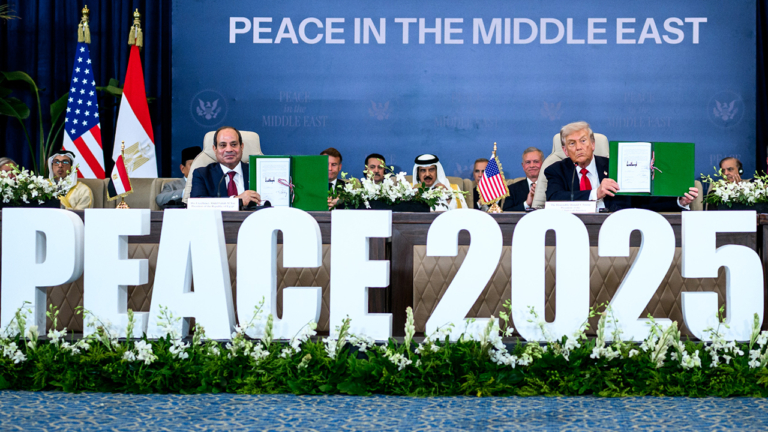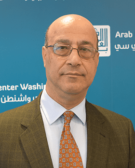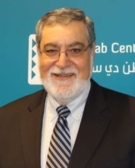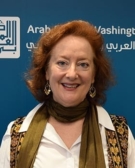
On October 13, 2025, just hours after President Donald Trump delivered a triumphal speech to the Israeli Knesset, he and other world leaders gathered in Sharm el-Sheikh, Egypt, to endorse the ceasefire agreement between Israel and Hamas intended to end Israel’s genocidal war on Gaza that has killed a reported 70,000 Palestinians. The ceasefire’s initial phase, agreed to by Hamas and Israel on October 9, 2025, and now in effect, is supposed to include the release of Israeli and Palestinian detainees, Israel’s withdrawal from parts of the Gaza Strip, a surge of humanitarian aid, and the return of displaced Gazans to their home areas.
The ceasefire followed the White House’s September 29, 2025, release of Trump’s broader “20-point peace plan” for Gaza, which the Sharm summit notably declined to endorse. Instead, the four ceasefire mediators—the United States, Egypt, Qatar, and Turkey—signed a brief document bizarrely titled “the Trump Declaration for Enduring Peace and Prosperity.” Neither Israel nor Hamas signed the Declaration—a strange turn that sheds much negative light upon what the conveners in Egypt probably had hoped would be a breakthrough summit.
Indeed, rather than serving as a forum for hashing out difficult next steps for Gaza, the Sharm summit was largely a congratulatory gesture to US President Donald Trump, who wanted to appear as the principal peacemaker. The “Trump Declaration” is replete with generalities and lacks the specifics necessary to achieve a lasting ceasefire, not to mention reconstruction and actual peace in Gaza. Unlike Trump’s controversial 20-point plan, the Declaration says nothing, for instance, about who will govern Gaza or who will stabilize and rebuild the destroyed enclave, instead featuring empty verbiage such as “strengthening bonds among nations and peoples serves the enduring interests of regional and global peace and stability.” Another telling absence from the summit was that of Israeli Prime Minister Benjamin Netanyahu, who is said to have been pressured by the US president to acquiesce to the ceasefire and the return of displaced Palestinians despite his right-wing government’s genocidal actions in the Gaza Strip over the last two years.
Arab Center Washington DC (ACW) asked its fellows and affiliates to provide their brief perspectives on the Sharm el-Sheikh summit, the ceasefire agreement, and Trump’s declaration. Their responses are below.
Hamas, the Palestinian Authority, and Post-War Gaza
Hanna Alshaikh, Palestine Project Coordinator
Palestinian responses to Trump’s 20-point peace plan share one principle: solutions cannot bypass the Palestinian people, and internationalization of a ceasefire plan should create accountability for Israel, not sideline Palestinians. Despite tensions, both Hamas and the Palestinian Authority (PA) call for clearly defined paths to sovereignty and self-determination. Following the symbolic theatrics of statehood recognition at the UN General Assembly weeks ago, the plan’s proposed “Board of Peace” to oversee Gaza is the other side of internationalization: the threat of international trusteeship in Gaza. This threat harkens back to the British Mandate for Palestine—which also claimed to prepare Palestinians for a self-rule and an independence that never came about.
For different reasons, both Hamas and the Fatah-dominated PA see a Palestinian state as necessary for post-war Gaza. Hamas insists that it will surrender its arms only to a Palestinian state. In 2024, Hamas agreed to an Egyptian proposal for technocratic administration in Gaza, negotiated in Cairo, which seemed promising until PA President Mahmoud Abbas withdrew suddenly from the talks. The Trump Plan has revived the idea of interim technocratic rule but places it under the Board of Peace until the PA completes a “reform” process that would qualify it to return to governing Gaza for the first time since 2007.
The question of the roles of Hamas, Fatah, and the PA in post-war arrangements is inseparable from the White House’s 20-point plan, which would formalize heavy external oversight of Palestinians. The plan would impose short-term control over local and municipal administration and would even make the return of the PA to Gaza contingent on “reform” and on Gaza’s “de-radicalization”—terms that are vague, leave room for shifting goalposts, and avoid political realities in Gaza and the occupied West Bank.
The Trump Plan and the Sharm el-Sheikh Declaration may secure a brief ceasefire, but in the absence of a pathway that affirms Palestinian self-determination or accountability measures for Israel’s genocide, the most likely possible outcome is a fragile, temporary calm.
Gaza Residents Are Returning. What of Humanitarian Aid?
Yara M. Asi, Non-resident Fellow
After all the incalculable losses of the past two years, many Palestinians in Gaza have started to experience their first moments of reprieve. But for most, these moments of relief are overtaken by harsh realities. The majority have no homes to return to, no schools for their children to attend, and no functioning hospitals nearby. Hunger is still rampant, and we cannot even begin to quantify the unmet health needs across the population. What little arable land existed in Gaza before the war is now largely destroyed and unsafe for agriculture due to unexploded ordnance and environmental pollutants. What does life in Gaza look like now and in the near future?
At least part of the answer to that question is that many in Gaza will be heavily dependent on the humanitarian aid that Israel has severely restricted since October 7, 2023, especially in recent months, and whose delivery is still dependent on Israeli cooperation. Indeed, just days after the ceasefire went into effect, Israel reneged on its commitments to allow at least 600 aid trucks to enter each day, instead limiting them to 300, and to reopen the Rafah border crossing with Egypt—two bare minimum requirements for a meaningful aid surge. Israel’s reversal has stymied efforts to bring aid into famine-affected parts of Gaza, especially Gaza City, which has not received any assistance in weeks.
Immediately after the ceasefire began, humanitarian agencies lauded the sudden change in their ability to bring in and distribute aid to the people who need it—evidence that large influxes of aid were possible at any time, had Israel permitted them during the long siege of Gaza. Now the same agencies are reporting that their access has again been restricted.
Importantly, this humanitarian aid—food and medicine delivered in trucks—is just the beginning of what Gaza will need to recover. Humanitarian agencies are not equipped to rebuild entire societies. While people in Gaza have made efforts to clean up the small amount of remaining infrastructure, a massive removal enterprise is required for the many thousands of tons of rubble that now cover Gaza. Building supplies will need to enter rapidly, as will equipment for hospitals, schools, markets, farms, and all other forms of civilian infrastructure. It remains unclear who will pay for all of this, and when—let alone where all the survivors are supposed to live in the meantime, as Israeli forces still occupy more than half of Gaza.
Gaza’s people deserve more than aid—they deserve justice. If the first few days after the ceasefire are any indication, however, they will continue to receive too little of the former, and none of the latter.
The Arab World Welcomes Agreement
Imad K. Harb, Director of Research and Analysis
It is hard to imagine the Arab world and Arab leaders not being enthusiastic about a so-called peace summit meeting for a Gaza ceasefire organized by a sitting US president, especially Donald Trump. Since the start of Israel’s war on Gaza in October 2023, they have lobbied the United States for a cessation of the hostilities that have killed tens of thousands of Palestinians and wrought utter devastation on the Gaza Strip. However, their efforts practically came to naught under President Joe Biden’s administration and Donald Trump’s White House both declaring their undying support for Israel’s war on the Strip and continuously supplying weapons under the pretense of the Zionist state’s supposed right to defend itself. In the end, the ceasefire in Gaza—whether it holds or is sacrificed on the altar of the right-wing Israeli government’s open plans for occupying Gaza—has come as a godsend: no longer can Arab leaders justify ignoring the ongoing genocide as their populations voice dismay with the spinelessness of the Arab political order and those who manage it.
What was obvious at the summit meeting was a full endorsement by the Arab attendees of Trump’s so-called peace plan—not only for Palestine and Israel but also for the entire Middle East—despite the US president’s ignoring Palestinian political and national rights and, indeed, their right to speak for themselves at the summit or in the plans for the day after. To be sure, Arab leaders’ shows of adoration of Trump look and sound like obsequiousness dressed in diplomatic niceties. They should know by now that, unfortunately, Trump is unlikely to abandon his support for Israel—which comes at their expense and the expense of the Palestinians—because that assures him of the support that he and his Republican Party crave from Christian Zionists and other defenders of Israel in the United States.
Where Is Bibi?
Khalil E. Jahshan, Executive Director
President Trump’s October 13, 2025, visit to Egypt took the world by storm and attracted some 20 world leaders to Sharm el-Sheikh to celebrate what the White House dubbed “the Trump Declaration for Peace and Prosperity.” At the summit, the US president wasted no time in claiming that a new era of peace and harmony had descended upon the Middle East, ending the “3,000-year-old” conflict that had plagued the region. Putting aside the exaggerated claims and public relations antics that characterized the hastily arranged diplomatic gathering, the event raised more questions than it answered, including what the participants actually discussed, the political implications of the proposed plans, and absence of key players. Of particular concern was the no-show of Israeli Prime Minister Benjamin Netanyahu, who typically attends international gatherings to advocate for his policies and to promote his successes, whether factual or exaggerated.
Netanyahu did indeed receive a formal invitation to participate in the summit arranged by none other than President Trump, through a phone call from Israel with President Abdel Fattah el-Sisi of Egypt. However, he declined the personal invitation, citing the prohibition of travel during the Jewish holiday of Simchat Torah. Critics accused Netanyahu of backtracking after initially accepting the invitation due to political concerns and pressures at home and abroad. Diplomatic rumors in the region credit Turkish President Recep Tayyip Erdoğan with derailing Netanyahu’s plan to attend as Erdoğan reportedly threatened to withdraw if Netanyahu participated. Opposition in Israel to the prime minister’s attendance also played a role in Netanyahu’s change of heart, as he likely feared his participation would instigate the collapse of his fragile right-wing coalition, who want to continue the war in Gaza, permanently occupy the enclave, and expel Palestinians.
Other observers pointed to Netanyahu’s fear of appearing isolated in the company of such critics as Erdoğan, Mahmoud Abbas of the Palestinian Authority, and European and Muslim leaders who have been quite critical of Israeli policies in Gaza. Inside Israel, other concerns involve concerns that an unfriendly audience in Sharm might force Israel to agree to new compromises regarding Gaza. To be sure, though, Netanyahu’s absence prompted a sigh of relief from both friends and foes at Sharm el-Sheikh.
The Chances of Peace in the Middle East
Nabeel Khoury, Non-resident Fellow
When guns fall silent and battles cease, the victims of violence can breathe again, look for their dead and missing, and search for ways to continue living and build on newfound peace. But the end of battles is not the end of war. This fact is nowhere more obvious than in the Middle East. President Trump deserves credit for exploiting domestic and international pressures on Netanyahu and adding his own weight to achieve the current ceasefire and prisoner exchange. Contrary to Trump’s claims, the first phase of his 20-point plan—the release of hostages and prisoners—was the easy part. The hard part starts now.
The lovefest inside the Israeli Knesset, where Trump spoke before heading to the Sharm el- Sheikh summit, was an opportunity for the US president and the Israeli prime minister to congratulate themselves and their armed forces and to rejoice in the return of Israeli citizens held by Hamas for the past two years. There was nary a mention of Palestinians, and certainly no mourning of the nearly 70,000 Palestinian dead. Speeches by Trump and other leaders, both in Israel and at the summit, were replete with hyperbole and an unjustified declaration that an era of peace has dawned on the entire Middle East. These assertions belie conditions on the ground—a continued gap between what Palestinians want and need and what Israelis are willing to accept. Nor does the euphoria consider the complexity of Israel’s unresolved conflicts with Iran, Lebanon, Syria, and Yemen.
The Trump peacemakers are now focused on expanding the 2020 Abraham Accords, betting that trade, investment, and commerce can guarantee Middle East peace through prosperity. This gamble ignores conflicting nationalist sentiments, the critical importance of self-determination, and the ability of enemies to put aside their mistrust of one another and agree to coexist. Israel has yet to indicate its willingness even to contemplate complete withdrawal from the occupied territories and to consider living side-by-side with an independent Palestinian state.
Trump’s Peace Prize, or More Lies?
Laurie King, Member of the Board of Directors
In the lead-up to the Nobel Committee’s announcement of this year’s Peace Prize awardee, President Trump and his chorus of supporters suggested that the prize should go to him for ending two years of carnage in Gaza—and for a day or so, it looked like this might actually happen. In the end, Venezuela’s opposition leader won the prize. Trump did not publicly pout or complain, though. He was basking in the limelight of the Sharm el-Sheikh summit and of the Israeli Knesset for pushing forward a deal between Hamas and Israel to release the remaining living Israeli hostages and halting Israel’s merciless pounding of Gaza and its extermination of Gaza City.
As many commentators have noted, the deal that clinched the October 2025 ceasefire was virtually indistinguishable from the deal on the table between Hamas and Israel in early 2025. This agreement could have, and should have, been accomplished months ago. It was not, however, because Netanyahu calculated that his political survival was more important than rescuing Israel from its status of global pariah. It is entirely possible that the unprecedented Israeli attack on Doha on September 9, 2025, tipped the scales of Washington’s tolerance for Israel’s military adventurism.
At the Knesset, Trump crowed that he had freed “our hostages”– equating Israelis with Americans. The US media has focused intensely on the return of Israeli captives and their families’ joy, while mostly ignoring the release of the 2,000 Palestinians held hostage by Israel. Just as they criticized Americans who were not sufficiently sad about the assassination of right-wing activist Charlie Kirk last month, Trump supporters are now complaining that defenders of Palestinian rights are not celebrating the ceasefire.
While Gazans are understandably relieved to see the partial withdrawal of Israeli forces and the cessation of buzzing drones and lethal airstrikes, this US-mediated ceasefire does not augur the changes in vision, policy, or strategy that are so necessary to bringing peace and justice to the Israeli and Palestinian peoples. Like so much of Trump’s politicking, it is a carnival barker’s show that puts him in the spotlight. And at the end of the day, the spotlight is what matters most to Donald Trump.
The views expressed in this publication are the authors’ own and do not necessarily reflect the position of Arab Center Washington DC, its staff, or its Board of Directors.
Featured image credit: Flickr/The White House






